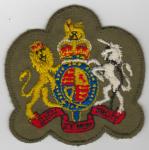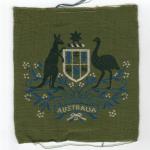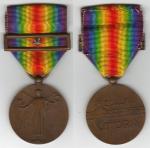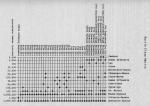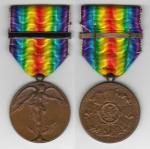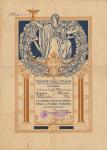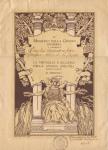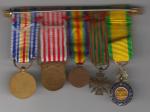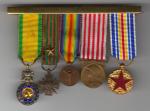-
Posts
1,170 -
Joined
-
Last visited
-
Days Won
1
Content Type
Profiles
Forums
Blogs
Gallery
Events
Store
Everything posted by RobW
-

Portuguese Victory Medals
RobW replied to Tim B's topic in Inter-Allied Victory Medals of the Great War
Hello all, Here is a pic of an official type 2 Portugal vic with the combatant star and typical ribbon buckle. Interested to see that this particular thread has had, as of today, 3,160 views. At least some people are looking! Due to work commitments I will be having a break for a while. Regards, Rob -

American (US) Victory Medals
RobW replied to Kev in Deva's topic in Inter-Allied Victory Medals of the Great War
-

Belgium My Collection of ODMs of Belgium
RobW replied to Riley1965's topic in Northern European & Baltic States
To all, As Hendrik has indicated there is also the black enamelled bar, also commonly known as the 'Mothers Bar' indicating a posthumous award. Here is a 'Mothers Bar' attached to a Belgian victory medal. This is an original bar, noting that the black enamel is flush with the top surface and edge rim of the bar. There is a later contemporary copy of the bar which is slightly longer and wider than the original, and has a wider rim. It does not however have the black enamel centre; it is just a black painted hollowed recess. Regards, Rob -

American (US) Victory Medals
RobW replied to Kev in Deva's topic in Inter-Allied Victory Medals of the Great War
Hello Tim, When I have time this weekend I shall scan the table and post a pic here. I am hopeful the Intellectual Property and Copyright gods won't complain too loudly about such a small excerpt from Mr Laslo's 23 year old first edition. Regards, Rob -

American (US) Victory Medals
RobW replied to Kev in Deva's topic in Inter-Allied Victory Medals of the Great War
Hello Thomas, Here are a couple of U.S. vic mini's that I could quickly find that have both engagement and country clasps as well as one that has a Navy service clasp. I have others that do not have clasps but I can't locate them at the moment. Aside from the centre two mini's you will notice that there are minute obverse differences between all the mini's and that should be expected. Of note is some of the alternate spellings of the clasps with 'Montdidier-Noyon' spelt two different way depending on the manufacturer of the bars. As I mentioned before I think a good collection of vic mini's will both highlight and complement any substantial vic collection. Regards, Rob -

American (US) Victory Medals
RobW replied to Kev in Deva's topic in Inter-Allied Victory Medals of the Great War
Hello Tim, No it is not the same but it's close. The clasp matrix is similar and lists the U.S. divisions along the top, with the clasp names on the right side, and approximate quantities involved on the left. It appears that it is a case of the same data just presented in a slightly different format. When I'm conducting research on U.S. vics with engagement bars I generally refer to this table initially, as well as a larger compilation which is based on 'Battle Participation of Organizations of the American Expeditionary Forces in France, Belgium and Italy 1917-1918' by the U.S. War Office, 1920. This reference lists all the divisions and then identifies the engagement (battle) or service (country) bar (clasp) entitlements down to Regimental level and below if applicable. While the amended list is based on the original publication it has been updated with other information from other sources. It is a handy reference to just conduct a quick first line check to make sure that the medal in question is not a 'fantasy' award made up with clasps added by vendors. I have a similar listing which is based off the official Navy lists and has been updated, from time to time, at the US Navy Historical Website, or at <http://www.history.navy.mil/medals/ww1vic.htm> Hope this helps. Regards, Rob -

British Victory Medals
RobW replied to Kev in Deva's topic in Inter-Allied Victory Medals of the Great War
Hello Thomas, The full-size medal looks okay as an official type 2 Great Britain variety (with W.McM designers name on the obverse), and the mini has a nice finish as well. The ribbon appears to be the correct type as it was slightly wider than the French or other country ribbon at 38 mm. As you have only posted the obverse of the full-size vic it is difficult to tell if the medal is a standard Great Britain type or the bi-lingual South African type. Considering these were sold as a pair, (full-size and mini) you do need to consider where the recipients other medals are. It is unusual but not necessarily untoward that you could find a single vic with an MID both full size and mini. Due to overlapping award criteria the victory medal was not awarded by itself. There should be, at the least, an accompanying British War medal and, if the person served in a designated theatre of war between August 1914 and before the end of 1915, also a 1914-15 Star. In many cases the British War Medal was subsequently sold for the silver content or melted down, leaving a lot of Great War trio's or pairs minus the BWM and thus a 'broken' group. I would conduct some research with the vendor in question in order to ascertain what other awards the recipient may have and where they might be. In that regard having the persons regimental details impressed on the rim will allow for some detailed research to be conducted. In addition, as there is a Mention-In-Despathces (MID) emblem on the full-size and mini, there should also be the opportunity to check the relevant Gazettes to confirm that the MID was awarded and for what actions it may have been awarded. Having the MID should make the recipient a little easier to research as all MID's were gazetted and are thus checkable. If you go to an earlier post on this thread there are some web-links to the National Archives in the U.K which may be of help. Of course this is all moot if the recipient is a South African so research would have to be re-directed to the appropriate places there if that is the case. As for the Laslo volumes I would recommend that you attempt to locate a copy of the 2nd edition. It updated the first edition in a lot of areas and, with the exception of the Battle Clasp matrix for the U.S. Victory medal, there is nothing that is not contained in the 2nd edition. The last time I checked there was a copy listed at 'abebooks.com' and a number of copies listed on 'used.addall.com' although none of the copies are cheap. After that there is always the on-line auction option. Regards, Rob -

American (US) Victory Medals
RobW replied to Kev in Deva's topic in Inter-Allied Victory Medals of the Great War
Hello Thomas, As Tim said - welcome back to the thread. I too like the whole collecting field of miniatures. There are just so many varieties of the full-size vics and there are also quite a few corresponding varieties of mini's. Miniatures are a whole new area of vic collecting which is what makes it such fun. They pose more of a research dilemna as they are not generally named or attributed to an individual although I do have a small Great Britain group named to an individual on the reverse of the mounting bar. The mini's of the U.S. and the Great Britain are generally seen in a consistent 18 mm diameter while other countries mini's are seen in a variety of diameters. I have 7 different Great Britain vic mini's and they are all different in strike, minor detail, and reverse lettering and all have been seen on different miniature groups. Some are more detailed than others. Other countries like Belgium, France, and Italy have mini vics in a range of sizes from 11 - 18 mm and they too are very finely detailed pieces. It is my view that the standard of the contemporary miniature medal workmanship is far better than what is generally seen in modern pieces. When I am back in Sydney in a couple of days I shall post some pics of a few different strikes of the U.S. vic mini's with a number of different Army engagement bars and Navy service bars for comparison. Regards, Rob -

British Victory Medals
RobW replied to Kev in Deva's topic in Inter-Allied Victory Medals of the Great War
Tim, A good place to start in the research for U.K. medals is the National Archives. They have a web presence at: http://www.nationala...ocumentsonline/ This has links to all the services as well as Army specific links to the Medal Index Cards, an electronic copy of which can be paid for and downloaded. You could also look at Ancestry.co.uk. It has a military search area as well with links to service records, pension records, and medal rolls among others. http://search.ancest...ult.aspx?cat=39 Regards, Rob -
To all, This has already been posted on the specific Belgium thread but I thought I would post it here for completeness as it is one of my favourite mini groups. Like the French miniatures Belgian vic min's were produced in a number of different sizes from 11 - 18 mm in diameter. The Belgian vic mini in this group is 13.5 mm. Of note is the level of detail on the orders, and in particular the enamel work. Due to the limited number of participants the campaign medal for the African Campaign is not often seen. L-R: * Officer of the Order of the Crown * Officer of the Royal Order of the Lion, with palm * War Cross, with palm * Commemorative Medal of the African Campaign * Volunteer Combatants Medal * Belgian Victory Medal * War Commemorative Medal Regards, Rob
-
Hello Tim. I have checked the front and back of the ribbon and there are no pin holes or marks. Even directly underneath the large star there are no pin marks. Where the screw has been pushed through the ribbon it has left a large hole but this has not caused any pulls in the ribbon. On closer inspection it just looks like the individual has just placed a larger than normal star on his ribbon. Regards, Rob
-
Hello all, I recently picked this 1914-1916 Croix de Guerre as part of a small 3 group consisting of the CDG, Combatant Cross, and victory medal. Being primarily a victory medal collector I was intrigued by the size of the bronze star on the CDG. It is secured by a screw attachment on the reverse as seen on the pic. I have checked my copy of 'Petite Histoire De La Grande Guerre Au Travers Des Décorations Attribuées Aux Poilus' by André Pascual and it doesn't mention it there. It is far larger than any other bronze star I have seen nor any of the others posted here. Is this an official or unofficial attachment? Happy for any thoughts as to what a bronze star this size represents. Regards, Rob
-

Italian Victory Medals
RobW replied to Kev in Deva's topic in Inter-Allied Victory Medals of the Great War
Here is the Italian Navy vic award certificate. It is larger than the Army certificate measuring 27.5 cm x 39 cm. It was also large enough that it had to be scanned in two parts and re-joined. This one was issued as late as December 1931. This is the more difficult of the italian vic award certificates to obtain. While they do appear on the market it is much less frequent than the Army variety. Regards, Rob -

Italian Victory Medals
RobW replied to Kev in Deva's topic in Inter-Allied Victory Medals of the Great War
To all, Seeing as I mentioned certificates and for those yet to see them, here is the Italian Ministry of War (Army) victory medal award certificate. The certificate measures 25 cm x 35 cm. It is large enough that it had to be scanned in two parts and then re-joined. It may not be immediately noticeable but there is a circular embossed authority seal just above the left hand (as viewed) of victory. This is in addition to the stamped Military District seal on the bottom of the document. This and the Navy award certificates have such lovely detail. The Italian Ministry of the Navy vic award certificate will follow. Regards, Rob -

British Victory Medals
RobW replied to Kev in Deva's topic in Inter-Allied Victory Medals of the Great War
To all, Here is the ribbon bar for the Great Britain group of 3 above (post # 12). The silver rosette on the 1914 Star denotes the award of the 'Aug-Nov' bar as is the miniature MID device on the vic ribbon. Regards, Rob -

WW1 Victory Medals General Discussion
RobW replied to JimZ's topic in Inter-Allied Victory Medals of the Great War
Hello Thomas, The medals in the vic series are just the beginning. Once you start down the path of collecting vics it becomes a little bit of a larger world. The official medals themselves then lead you to all the myriad of unofficial strikes, re-issues, contemporary to the time (1920s) and later repro's, and that is just the full size ones. On top of that you have the miniature vics which are fascinating in themselves and the award certificates of some of the countries are very imaginative and attractive pieces. As a collecting theme there always seems much to keep me busy with the vics. Once you start down the rabbit hole you don't know where it will lead you. Regards, Rob -

WW1 Victory Medals General Discussion
RobW replied to JimZ's topic in Inter-Allied Victory Medals of the Great War
Hello Thomas, Thanks for the kind words. I wouldn't characterise myself as a 'Grand-Master' but moreso just another collector. If you look at the other country specific threads you will also see some specific posts about their vics as well. Regards, Rob -
Hello Tim, Kev and all, Thanks for the 'heads up'. All ethical arguments about selling of such items and ebay rules aside it does indeed raise the topic of 'buyer beware' and if in doubt buy the book or obtain the knowledge. That, in itself, is a vexing issue for victory medal collectors because the last specific reference book by Mr Laslo is now 17 years old, and the knowledge is fragmented at best. Both editions of Mr Laslo's works are good reference material but in a number of areas time has moved on and more information has come to light since that time. I think one of the best ways to obtain the knowledge is to at least handle the pieces, both real and reproductions, and to have an eye for detail. That way at least you can determine what is a real one and what is a repro or a fake. High resolution digital photos and forums like this help for sure in getting the information out there. Half the challenge of having items for reference is to actually be able to pick the piece up, study it, and then document the changes between the real item and the repro. The promulgation of that knowledge on forums is a perennial problem as well because it involves the tricky question of 'Do we post the information and thereby educate the fakers, so that they can then improve their products, or do we keep the information to ourselves and hope that buyers are wary of possible fakes'? This is not something that I could offer any new insight into. I think that this cycle is bound to be repeated wherever there is something that is deemed collectible and therefore of value. Regards, Rob
-
-
-
Hello Chris, Here is a small group of French mini's with: * Medaille Militaire, made of silver * War Cross with star * Victory medal (11 mm) * War Commemorative Medal 1914-18 * Unofficial wound medal What I found interesting is the different size medals on the one bar as well as the hallmarks on the MM. In this case the French vic is 11 mm in diameter. Of note is that on the reverse of the MM there are the two Paris Mint cornucopia marks astride a numeral '1'. This number 1 was the period silver assay mark for a .900 silver minimum indicating the MM was made of high quality silver. Regards, Rob


